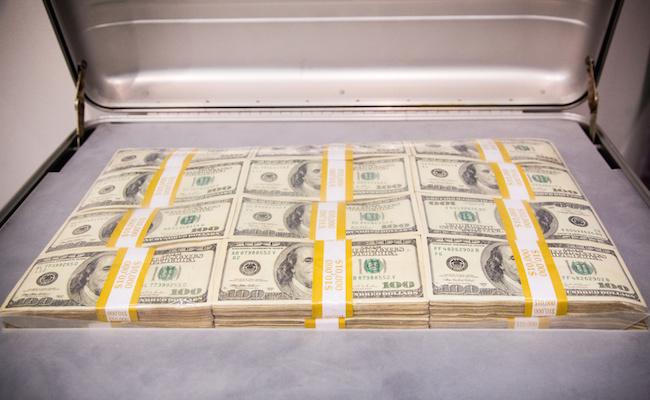Justin Crowe, CFile’s peripatetic writer-at-large went to the The Armory Show to check out their fruits of the kiln and ended up, briefly, extremely wealthy:
Using money as an art medium seemed prevalent at this year’s Armory Arts Week with Dustin Yellin getting loads of attention for shredding $10,000 and New York artist Jonathan Schipper leading this performance in which fairgoers had the opportunity to carry around a million dollars cash. It was performed at the Armory show, March 5-8th, 2105, and I seized the opportunity to be a millionaire for a quick ten minutes.

Jonathan Schipper
The piece was hosted by Pierogi Gallery, in a booth with a playful aesthetic dominated by John O’Connor’s word paintings. Against the back wall a piece stood out – a stainless steel suitcase containing a million dollars in cash, neatly packed and vacuum-sealed. At first it seemed strange that no one was worried about the large sum of money sitting out in the open with thousands of people passing by. But the money was a literal visualization of what was in every single booth at this art shopping mall for the super rich. I am imagining the Anish Kappors, Damien Hirsts, and Ken Prices as vacuum-sealed stacks of bills.
I had the pleasure of participating in Schipper’s Million Dollar Walk. On Friday and Sunday at the Armory show Schipper was handcuffing the armored suitcase to fairgoers and accompanying them on a stroll around the show, but not without precautions.

To prepare for my 10 minutes as a millionaire, Schipper collected my name, signature, and fingerprint in a small book that had ten or more names before me, a continuation of the list taped to the wall above the suitcase. He then photographed my ID, closed the armored case, secured the clips, and handcuffed me to the package. His instructions were simple: “You can go anywhere in the fair you want, but avoid the exits.” Schipper then accompanied me as my “bodyguard” on a walk.
As we set off, the first thing I noticed was how shockingly heavy the suitcase was and tried to make it look effortless, when in fact my hand was cramping and I had to put it down twice to rest. I began to get looks and stares as we walked, and engaged Schipper in conversation about the piece, his studio, and his side-business.

Schipper is best known for his car crash installation, The Slow Inevitable Death of American Muscle (2007-09) in which two cars collided slowly over a period of 6 days. The Million Dollar Walk performance at the Armory show was his latest spectacle. He told Artsy, “Art fairs are meeting points of art and money. I have noticed most articles about them seem to talk about the money first and art second. The show is made for people with money. I wanted to even the playing field, if only for 10 minutes per person.”
It was surprising how anticlimactic it was carrying the money. Maybe the excitement of being in the midst of the performance overpowered the thrill. Or maybe for the first time at the Armory Show I felt like I fit in. Last year Spear’s partnered with wealth consultancy company WealthInsight and found that one in every 25 New Yorkers is a millionaire. I’m sure the Armory show itself had an much higher concentration and for a moment I was (kind of) one of them.

CFile’s Justin Crowe
The piece creates two very different experiences – one for the carrier, and one for the curious onlooker. For a fairgoer seeing a young dreadlocked man handcuffed to a armored suitcase with a body guard must have been intriguing, a James Bond movie moment. Then again, it’s not THAT shocking at the Armory Show where you may imagine a young eccentric entrepreneur paying for his new Anish Kapoor sculpture in diamonds. The brilliance of the Million Dollar Walk was that is made the rich feel insignificant and the average feel important.
The question Schipper got repeatedly was “Is the money real?” His confident response each time was “Yes.” According to Artsy, the million was borrowed from Schipper’s iPhone case/eyeglasses business specifically for the performance. Upon returning to the booth, the handcuff was removed and an onlooker asked the artist how much the piece cost. “$1,020,000,” Schipper responded with a smirk. “… or $20,000 if you want to provide your own cash.”
Justin Crowe is Writer-at-Large for CFile.
Any thoughts about this post? Share yours in the comment box below.

Add your valued opinion to this post.